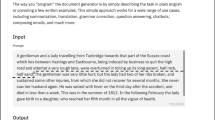Abstract
One may indicate the potentials of an MT system by stating what text genres it can process, e.g., weather reports and technical manuals. This approach is practical, but misleading, unless domain knowledge is highly integrated in the system. Another way to indicate which fragments of language the system can process is to state its grammatical potentials, or more formally, which languages the grammars of the system can generate. This approach is more technical and less understandable to the layman (customer), but it is less misleading, since it stresses the point that the fragments which can be translated by the grammars of a system need not necessarily coincide exactly with any particular genre. Generally, the syntactic and lexical rules of an MT system allow it to translate many sentences other than those belonging to a certain genre. On the other hand it probably cannot translate all the sentences of a particular genre. Swetra is a multilanguage MT system defined by the potentials of a formal grammar (standard referent grammar) and not by reference to a genre. Successful translation of sentences can be guaranteed if they are within a specified syntactic format based on a specified lexicon. The paper discusses the consequences of this approach (Grammatically Restricted Machine Translation, GRMT) and describes the limits set by a standard choice of grammatical rules for sentences and clauses, noun phrases, verb phrases, sentence adverbials, etc. Such rules have been set up for English, Swedish and Russian, mainly on the basis of familiarity (frequency) and computer efficiency, but restricting the grammar and making it suitable for several languages poses many problems for optimization. Sample texts—newspaper reports—illustrate the type of text that can be translated with reasonable success among Russian, English and Swedish.
Similar content being viewed by others
References
Dooley Collberg, S. 1988. A Preliminary Referent Grammatical Analysis of Relative Clauses in Modern Irish. Working Papers 33. Dept of Linguistics and Phonetics, University of Lund, Sweden.
Gazdar, G. 1981. Unbounded Dependencies and Coordinate Structures.Linguistic Inquiry 12, 155–184.
Gawronska-Werngren, B. 1988. A Referent Grammatical Analysis of Polish Relative Clauses.Studia Linguistica 42:1 (to appear).
Kosaka, M., Teller, V. & Grishman, R. 1988. A Sublanguage Approach to Japanese-English Machine Translation. In: D. Maxwell, K. Schubert and A. P. M. Wilkam.
Lang, E. 1984.The Semantics of Coordination. Amsterdam: John Benjamins B.V.
Maxwell, D., Schubert, K. and Wilkam, A.P.M. (eds.) 1988.New Directions in Machine Translation. Dordrecht, Holland-Providence, R.I.: Foris Publications.
Newmark, P. 1988.A Textbook of Translation. New York: Prentice Hall.
Nirenburg, S. (ed.) 1987.Machine Translation: Theoretical and Methodological Issues. Cambridge University Press.
Sigurd, B. 1987. Referent Grammar (RG). A Generalized Phrase Structure Grammar with built-in referents.Studia Linguistica, 41:2, 115–135.
Sigurd, B. 1988. Translating to and from Swedish by SWETRA—a Multilanguage Translation System. In: D. Maxwell, K. Schubert and A.P.M. Wilkam, 1988.
Sigurd, B. A. Referent Grammatical Analysis of Relative Clauses.Acta Linguistica Hafniensia (to appear).
Author information
Authors and Affiliations
Rights and permissions
About this article
Cite this article
Sigurd, B., Gawronska-Werngren, B. The potential of swetra—A multilanguage MT system. Mach Translat 3, 237–250 (1988). https://doi.org/10.1007/BF02144632
Issue Date:
DOI: https://doi.org/10.1007/BF02144632




